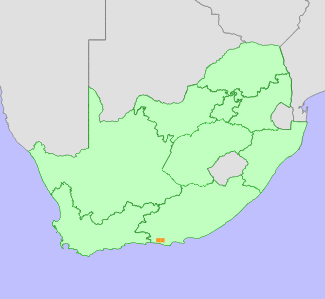|
Scientific Name | Aspalathus usnoides C.H.Stirt. & Muasya |
Higher Classification | Dicotyledons |
Family | FABACEAE |
Common Names | Oldmansbeard Capegorse (e) |
National Status |
Status and Criteria | Endangered B1ab(iii)+2ab(iii) |
Assessment Date | 2021/07/09 |
Assessor(s) | D.I.W. Euston-Brown & H. Mtshali |
Justification | This Kouga Mountain species has a restricted distribution, with an extent of occurrence (EOO) of 467 km², and an area of occupancy (AOO) of 36 km². It occurs at five locations that continue to decline due to spreading alien invasive plants. As a reseeder, this short-lived species is also potentially vulnerable to fire-related population fluctuation. It therefore qualifies for listing as Endangered under criterion B. |
Distribution |
Endemism | South African endemic |
Provincial distribution | Eastern Cape |
Range | This species occurs in the Kouga Mountains to the north of Kareedouw in the Eastern Cape Province, South Africa. |
Habitat and Ecology |
Major system | Terrestrial |
Major habitats | Kouga Grassy Sandstone Fynbos, Kouga Sandstone Fynbos |
Description | This shrub or small tree grows up to 5 m tall. It occurs on lower, steep, south facing slopes, at 300-400 m.a.s.l. It is short-lived and is a reseeder. It disappears from old fynbos that is older than about 15 years and exists only in seed form until the next fire. |
Threats |
| Habitat along the river where this species occurs is threatened by spreading invasive alien species, including Hakea sericea and Acacia mearnsii.
In addition, the valley where it occurs has less frequent fire than the more exposed slopes, and some parts may escape burning for long periods. Therefore, as a reseeder this species is likely to be negatively impacted by inappropriate land management, particularly infrequent fires. Monitoring is required. |
Population |
This species is localised to suitable habitat but following fire the species is locally common on the south facing slopes of Kouga Valley. Some of the subpopulations are inaccessible and hence difficult to monitor. The quality of habitat is declining as a result of the spread of invasive alien plants, the population trend is therefore inferred to be declining.
|
Population trend | Decreasing |
Bibliography |
Stirton, C.H. and Muasya, A.M. 2016. Seven new species and notes on the genus Aspalathus (Crotalarieae, Fabaceae). South African Journal of Botany 104:35-46.
|
Citation |
| Euston-Brown, D.I.W. & Mtshali, H. 2021. Aspalathus usnoides C.H.Stirt. & Muasya. National Assessment: Red List of South African Plants version 2024.1. Accessed on 2025/10/26 |
 Comment on this assessment
Comment on this assessment

